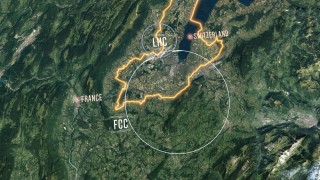The Future Circular Collider (FCC) collaborative team has published a conceptual design report showing options for the project. It is one of two options that will now be considered as a successor to the Large Hadron Collider (LHC) which is in operation at Cern's base in Switzerland near the border with France.
“The FCC’s ultimate goal is to provide a 100-kilometre superconducting proton accelerator ring, with an energy of up to 100 TeV, meaning an order of magnitude more powerful than the LHC,” said CERN director for accelerators and technology, Frédérick Bordry. “The FCC timeline foresees starting with an electron-positron machine, just as LEP preceded the LHC. This would enable a rich programme to benefit the particle physics community throughout the twenty-first century.”
The cost of a large circular electron-positron collider would be in the €9bn range, including €5bn euros for the civil engineering work for a 100km tunnel. This collider would serve the worldwide physics community for 15 to 20 years, said Cern. The physics programme could start by 2040 at the end of the High-Luminosity LHC. The cost estimate for a superconducting proton machine that would afterwards use the same tunnel is around 15 billion euros. This machine could start operation in the late 2050s.
The FCC collaboration has involved more than 1,300 contributors from 150 universities, research institutes and industrial partners.
Over the next two years, the particle physics community will be updating the European Strategy for Particle Physics, outlining the future of the discipline beyond the horizon of the LHC. The possibility of a future circular collider will be examined during the strategy process, together with the other post-LHC collider option at Cern, the Clic linear collider.

Decisions will be taken about a particle accelerator to succeed the LHC and enable a significant expansion in knowledge of matter and the universe.
The FCC would provide electron-positron, proton-proton and ion-ion collisions at unprecedented energies and intensities, with the possibility of electron-proton and electron-ion collisions.
“The FCC conceptual design report is a remarkable accomplishment,” said Cern director-general Fabiola Gianotti. “It shows the tremendous potential of the FCC to improve our knowledge of fundamental physics and to advance many technologies with a broad impact on society. While presenting new, daunting challenges, the FCC would greatly benefit from Cern’s expertise, accelerator complex and infrastructures, which have been developed over more than half a century.”
Cern said that the discovery of the Higgs boson at the LHC opened a new path for research, as the Higgs boson could be a door into new physics. Detailed studies of its properties are therefore a priority for any future high-energy physics accelerator. In addition, experimental evidence requires physics beyond the Standard Model to account for observations such as dark matter and the domination of matter over antimatter.
“Proton colliders have been the tool-of-choice for generations to venture new physics at the smallest scale. A large proton collider would present a leap forward in this exploration and decisively extend the physics programme beyond results provided by the LHC and a possible electron-positron collider.” said Cern director for research and computing, Eckhard Elsen.
Got a story? Email news@theconstructionindex.co.uk



